Modeling and Multi-Objective Optimization of Engine Performance and Hydrocarbon Emissions via the Use of a Computer Aided Engineering Code and the NSGA-II Genetic Algorithm
Abstract
:1. Introduction
2. Experimental Set-Up and Methods
2.1. Data Collection and Engine Modelling
| Description | Details |
|---|---|
| Engine type/Number of cylinders | Four-stroke/four cylinders |
| Number of valves per cylinder | 4 |
| Cylinder bore | 74.7 mm |
| Stroke | 84.7 mm |
| Compression ratio | 10.2:1 |
| Rated Power/Speed | 79 KW@5400 rpm |
| Idle speed | 750 +/− 50 rpm |
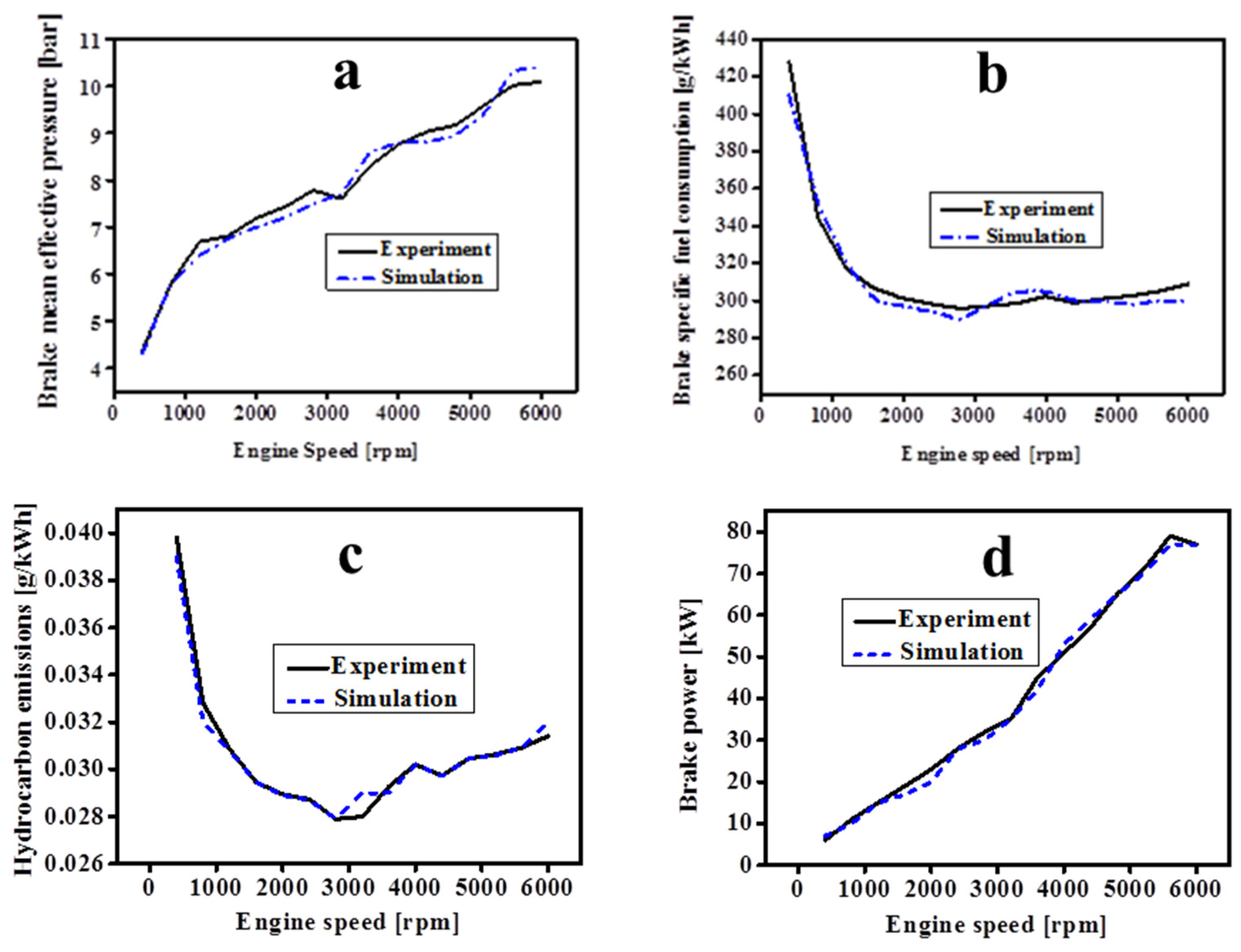
2.2. Design of Experiments and System Identification Using GMDH Polynomial Neural Networks
2.3. The Use of Singular Value Decomposition (SVD) for the Optimal Determination of Coefficients
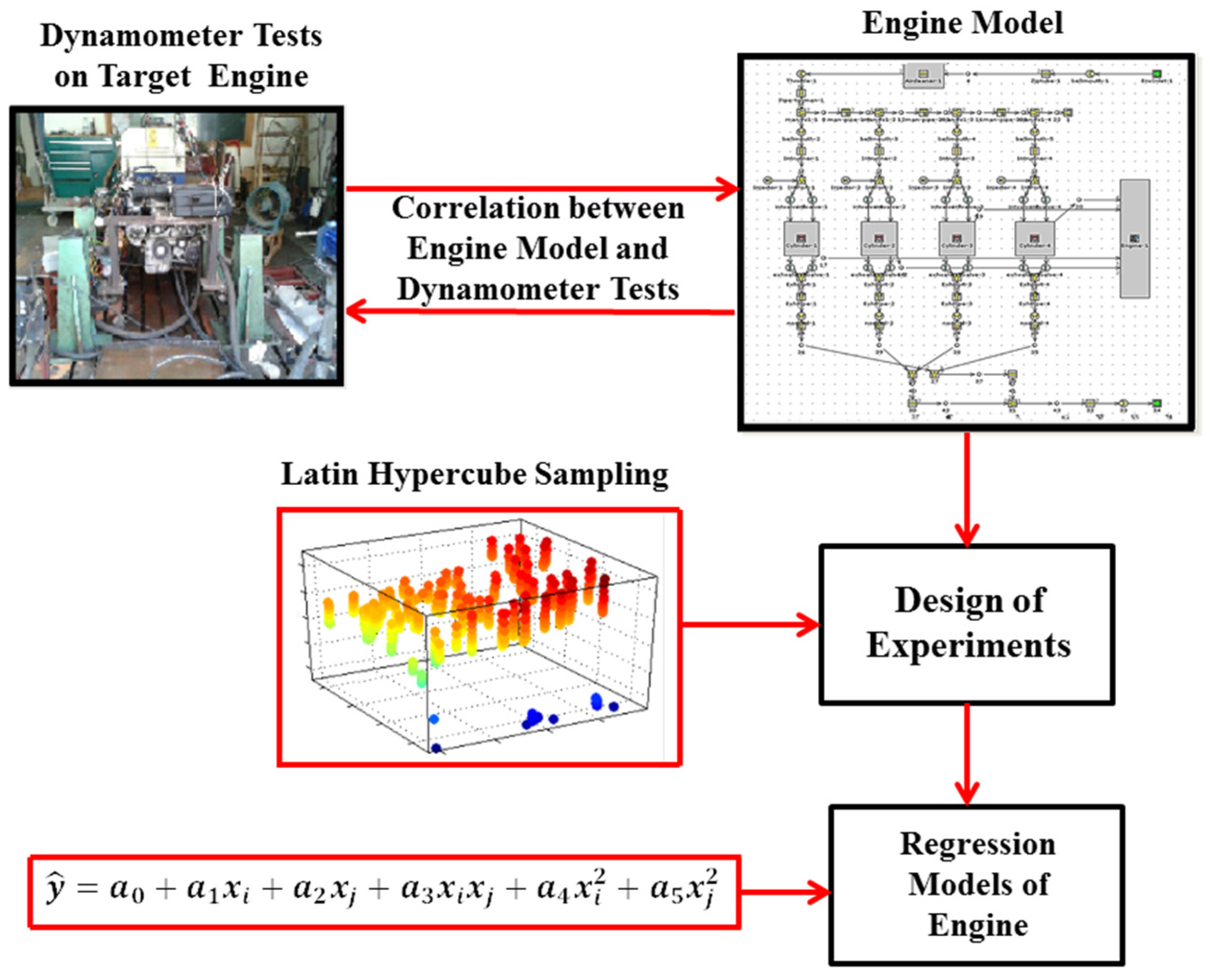
2.4. Multi-Objective Optimization
2.5. Pareto Dominance and Optimal Solutions
2.6. The Pareto Set and Optimal Frontier
2.7. Use of the NSGA-II Genetic Algorithm for the Multi-Objective Optimization Framework
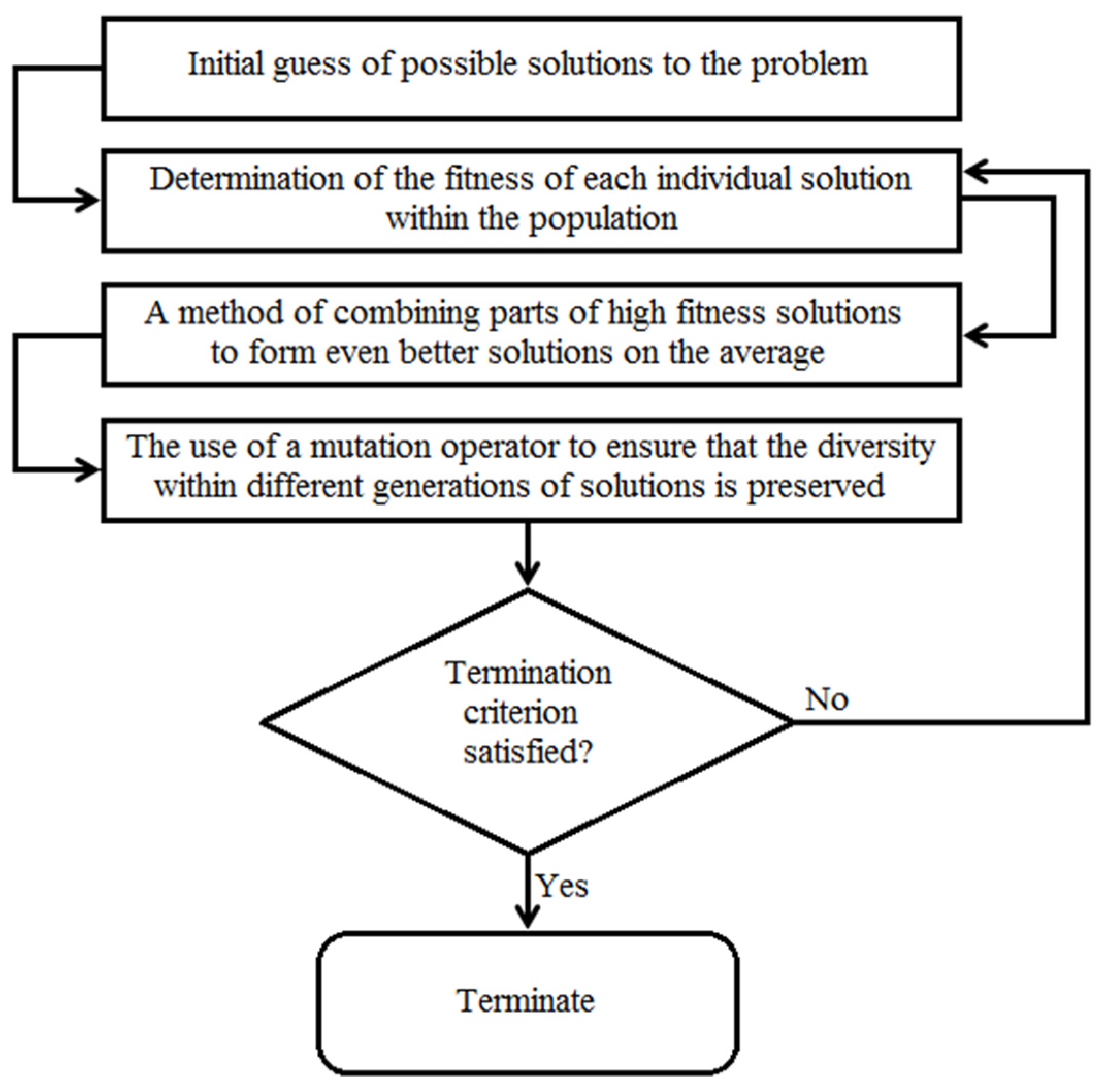
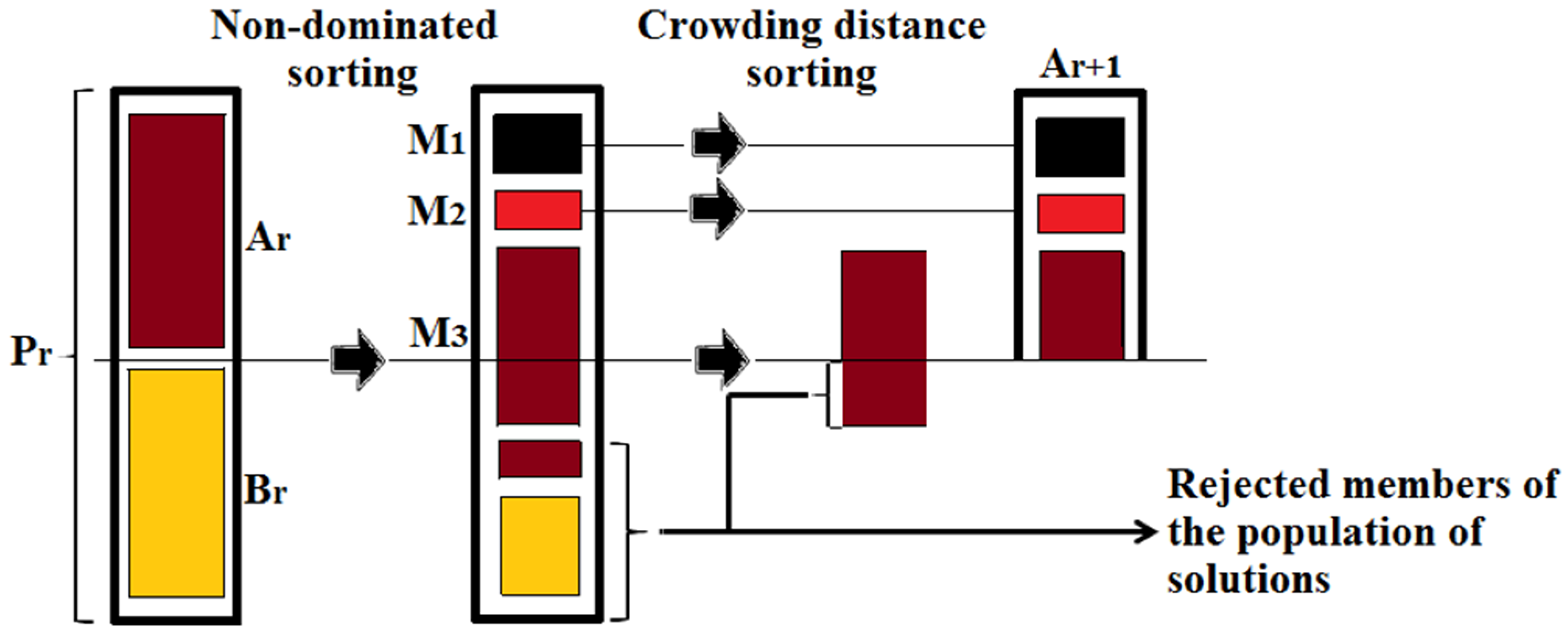
3. Results and Discussion
3.1. Results for Training GMDH Neural Networks
| Errors and Standard Deviation | Brake Specific HC Emissions | Brake Mean Effective Pressure | |||
|---|---|---|---|---|---|
| Training | Test | Training | Test | ||
| Mean Squared Error (MSE) | 0.0000032 | 0.000032 | 0.297 | 0.263 | |
| Root Mean Squared Error (RMSE) | 0.0018 | 0.0018 | 0.545 | 0.513 | |
| Mean Error (Absolute) | 0.0000039 | 0.000078 | 0.00399 | 0.0135 | |
| Standard Deviation (StD) | 0.0018 | 0.0018 | 0.545 | 0.545 | |
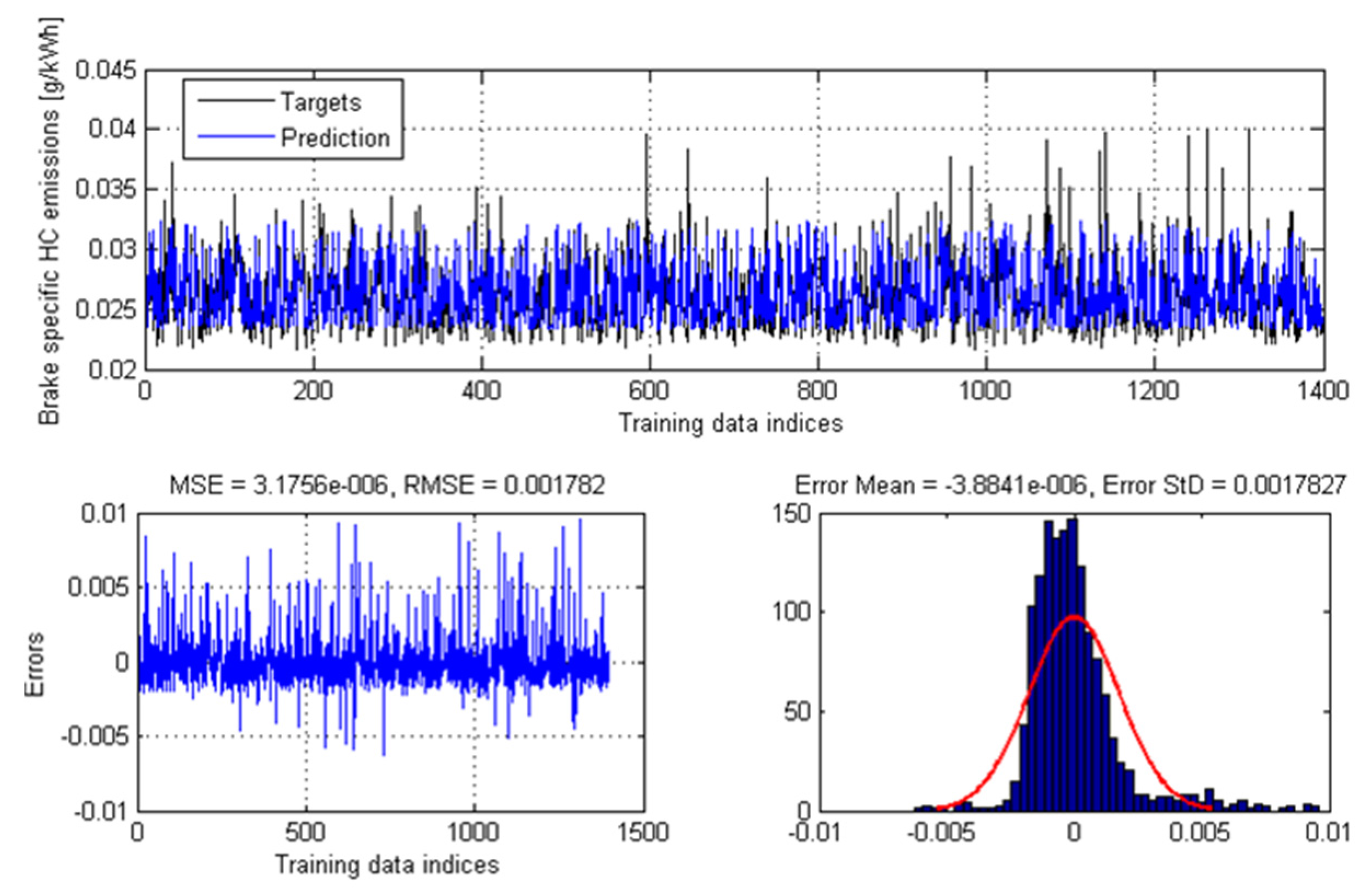
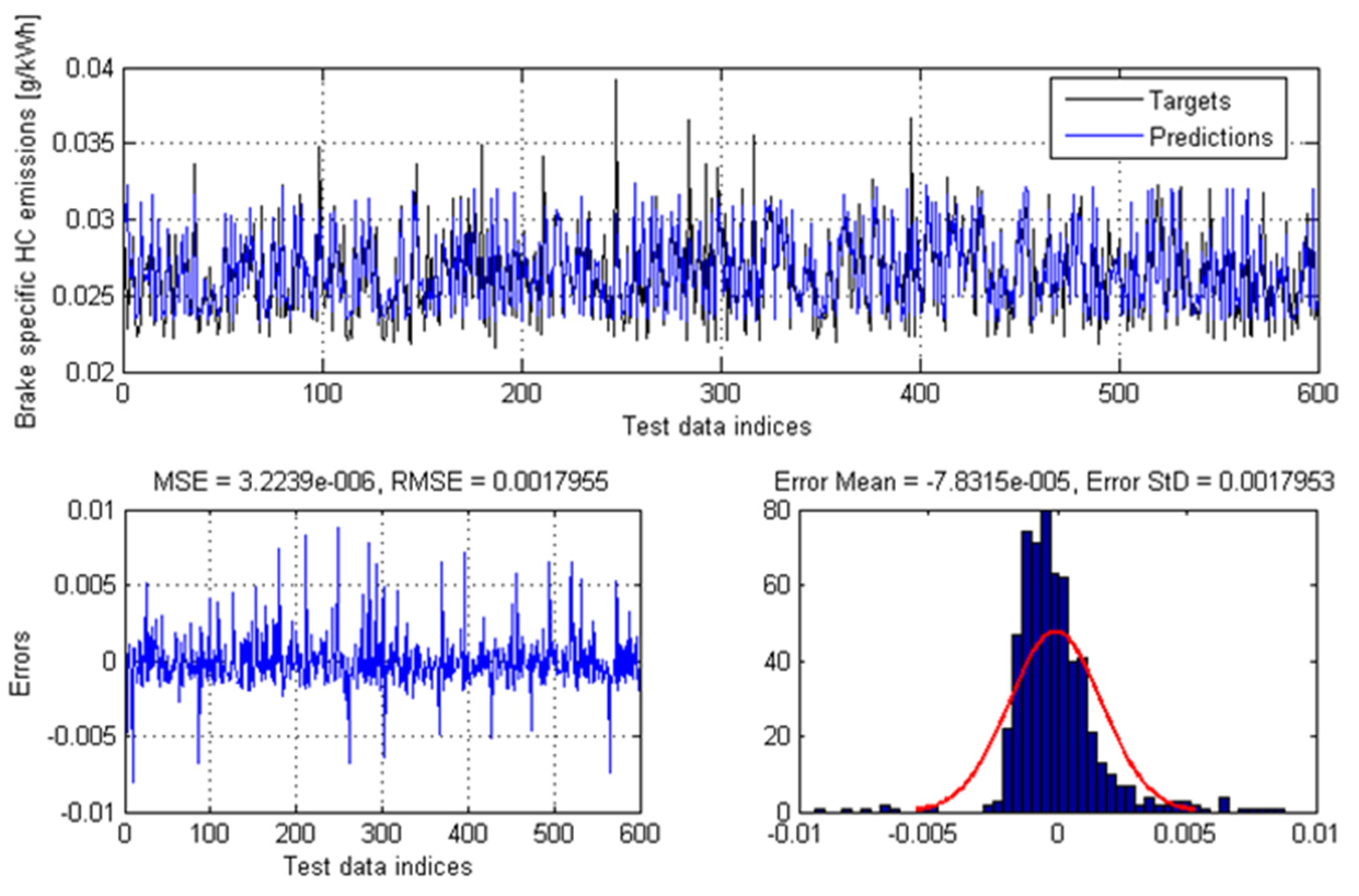
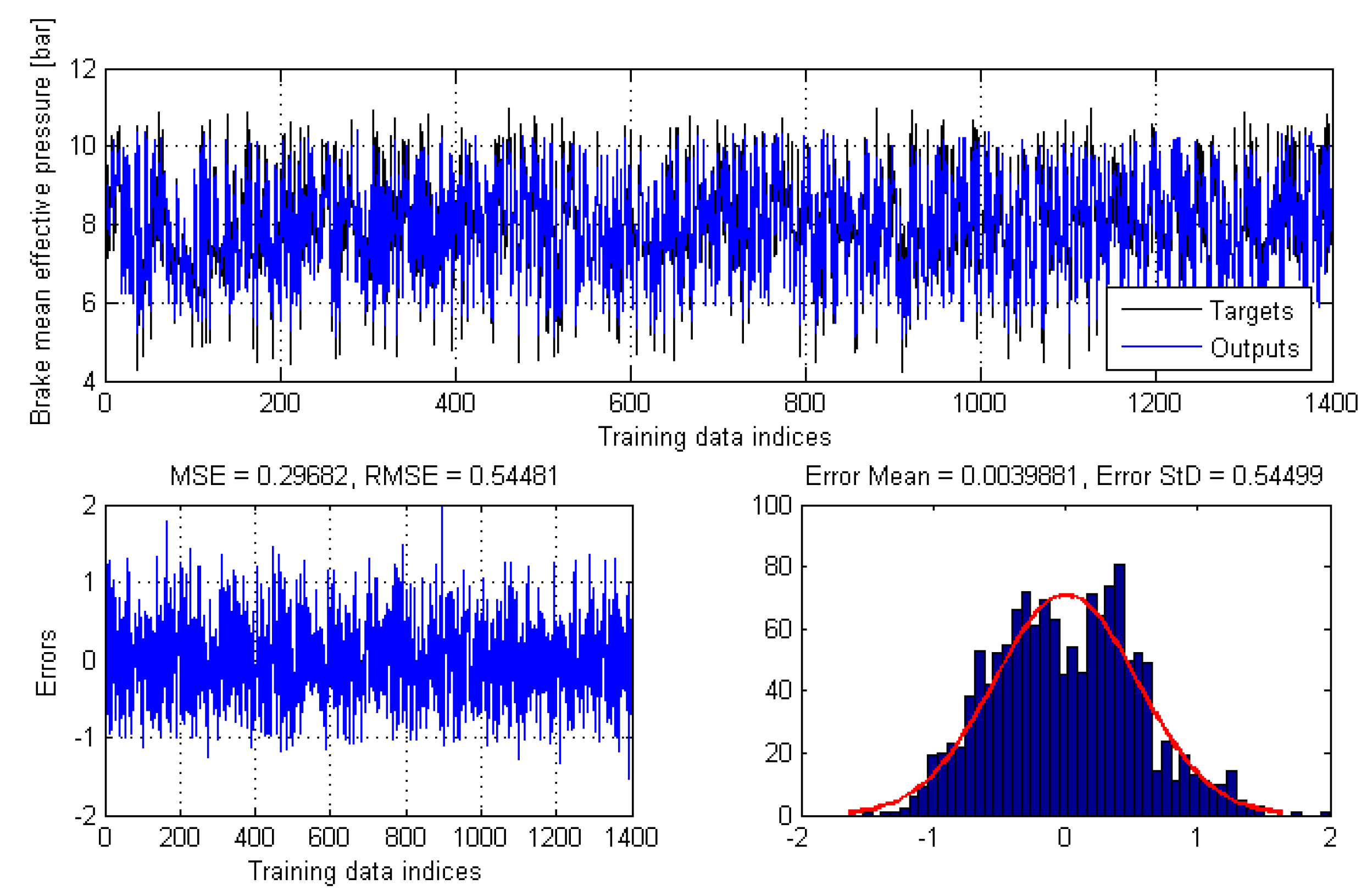
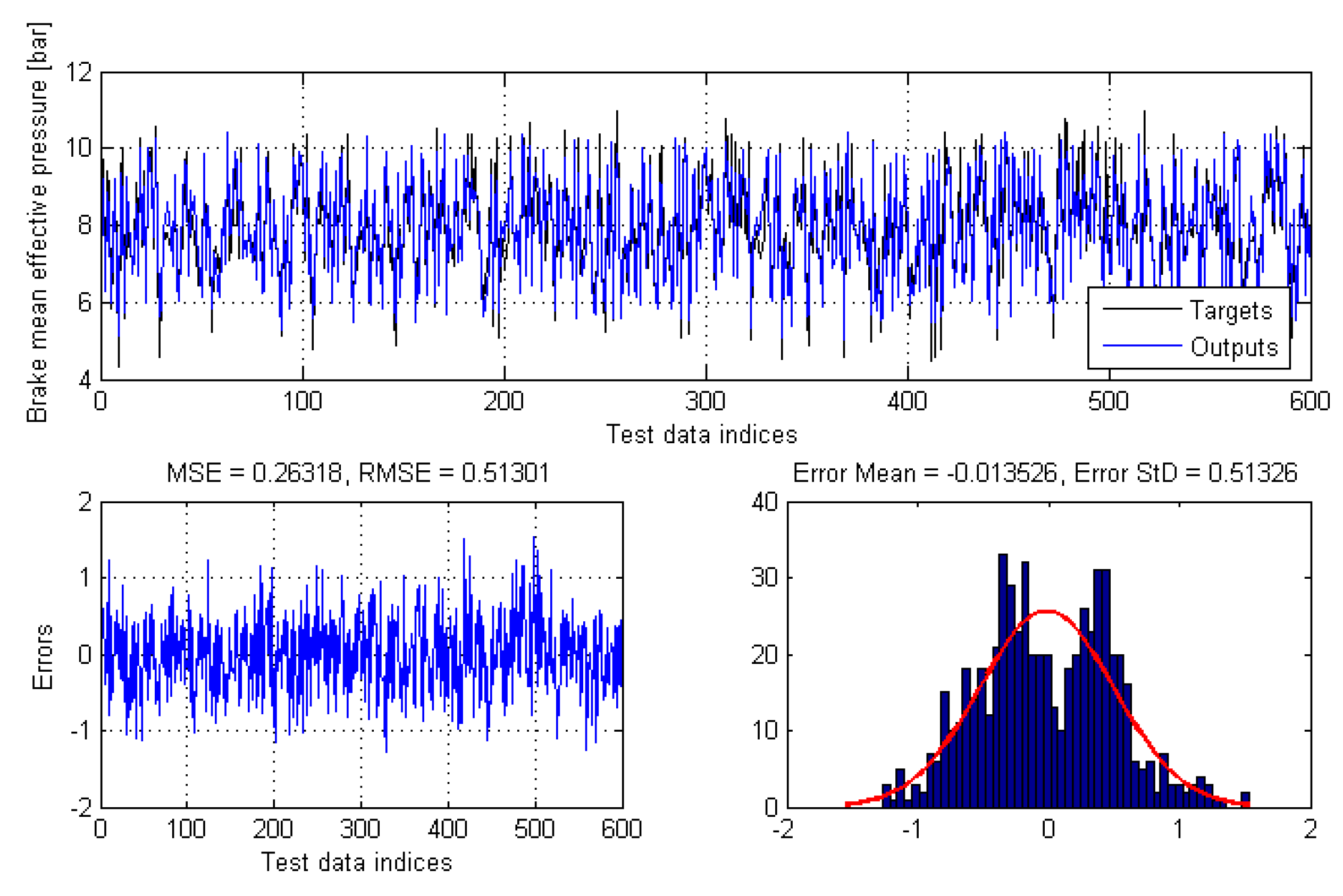
3.2. NSGA-II Multi-Objective Optimization Results
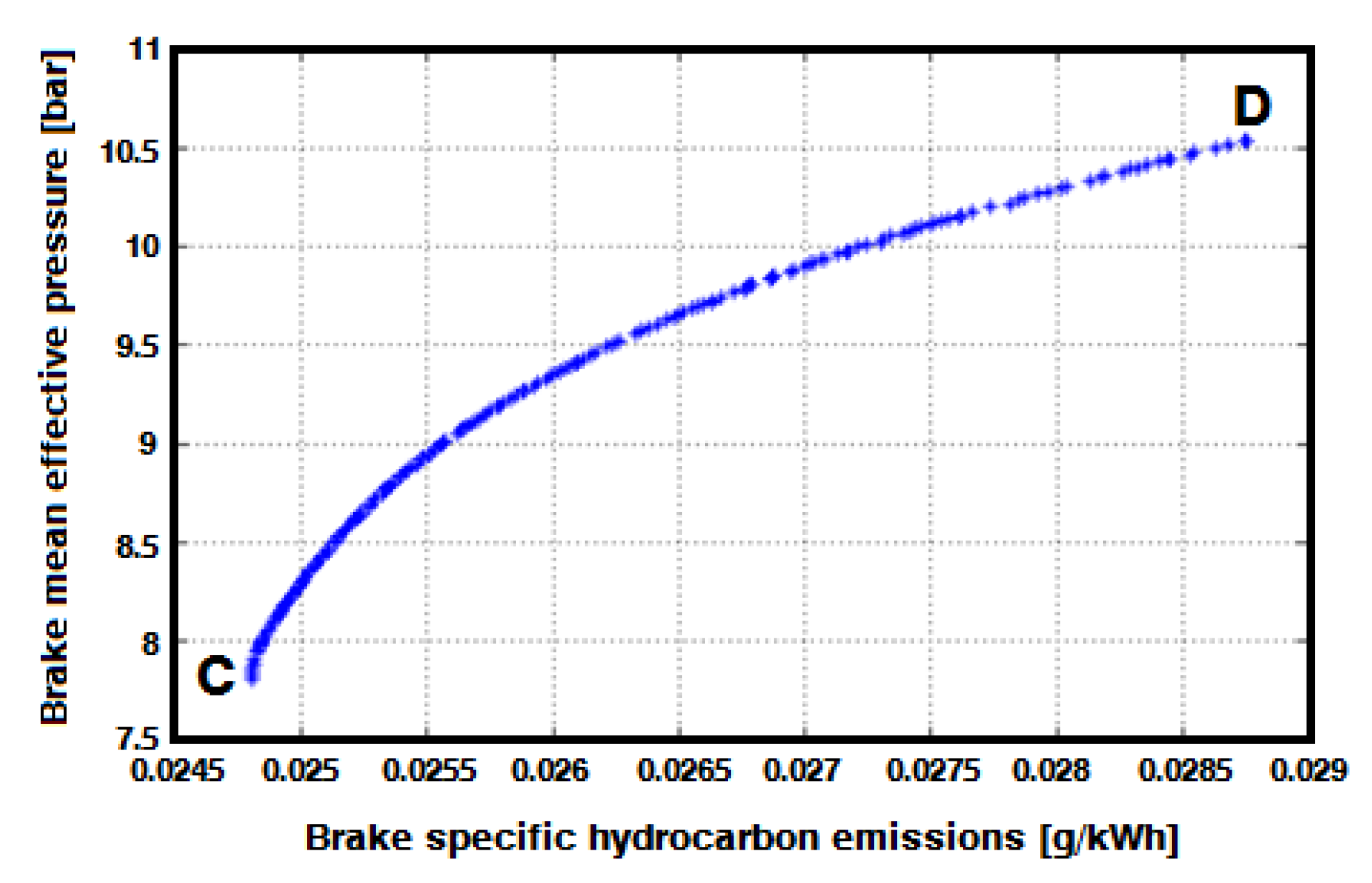

4. Conclusions
- The prediction accuracy of the engine models could be improved by using GMDH polynomial neural networks. However, the prediction accuracy could be even better if a larger number of training and test data sets were generated from 1D engine models (through Latin Hypercube Sampling) rather the collection of fewer data through experiments.
- For the purpose of achieving optimal results, the relationship between the two decision variables must be such that the fuel-air ratio lies close to 0.083 while the intake manifold length varied between 231 mm and 323.53 mm.
Acknowledgments
Author Contributions
Conflicts of Interest
References
- Tums, S.R. An Introduction to Combustion: Concepts and Applications, 2nd ed.; McGraw-Hill Education: New Delhi, India, 2000. [Google Scholar]
- Babu, M.G.; Subramanian, K. Alternative Transportation Fuels: Utilisation in Combustion Engines; CRC Press: Boca Raton, FL, USA, 2013. [Google Scholar]
- Lee, E.; Park, J.; Huh, K.Y.; Choi, J.; Bae, C. Simulation of Fuel/Air Mixture Formation for Heavy Duty Liquid Phase LPG Injection (LPLI) Engines; SAE International: Warrendale, PA, USA, 2003. [Google Scholar]
- Agostinelli, D.; Carter, N.; Fang, G.; Hamori, F. Optimization of a Mono-Fuel Liquid Phase LPG MPI Fuel System; SAE International: Warrendale, PA, USA, 2011. [Google Scholar]
- Helin, X.; Yusheng, Z.; Huiya, Z. Experimental and Numerical Study on the Characteristics of Liquid Phase LPG and Diesel Fuel Sprays; SAE International: Warrendale, PA, USA, 2006. [Google Scholar]
- Ramadhas, A.S. Alternative Fuels for Transportation; CRC Press: Boca Raton, FL, USA, 2012. [Google Scholar]
- Cipollone, R.; Villante, C. Model-Based A/F Control for LPG Liquid-Phase Injected SI ICEs; SAE International: Warrendale, PA, USA, 2004. [Google Scholar]
- Teene, E.A.A. Development and Modeling of a Liquid Phase LPG Fuel Injection System; ProQuest: Ann Arbor, MI, USA, 2007. [Google Scholar]
- Dill, S.; Anderson, E.; Taylor, B.; Dunbar, B.; Baker, M.; Tischler, T.; Wandrie, H.; Cheroudi, B.; Pinhas, B. Conversion of Engine Fuel System from Gasoline Injection to Liquid Propane Injection; SAE1997 International Congress & Exposition: Detroit, MI, USA, 1997. [Google Scholar]
- Shamekhi, A.-M.; Shamekhi, A.H. A new approach in improvement of mean value models for spark ignition engines using neural networks. Expert Syst. Appl. 2015, 42, 5192–5218. [Google Scholar] [CrossRef]
- Tumelaire, C.-F.; Gurney, D.; Cains, T.; Milovanovic, N.; Warth, M. Flexible ECU Function Development Calibration and Engine Performance Assessment Based on Co-Simulation. Available online: http://papers.sae.org/2013-01-0342/ (accessed on 22 December 2015).
- Wallner, T.; Lohse-Busch, H.; Gurski, S.; Duoba, M.; Thiel, W.; Martin, D.; Korn, T. Fuel economy and emissions evaluation of BMW hydrogen 7 mono-fuel demonstration vehicles. Int. J. Hydrog. Energy 2008, 33, 7607–7618. [Google Scholar] [CrossRef]
- Merkisz, J.; Pielecha, J.; Gis, W. Gaseous and Particle Emissions Results from Light Duty Vehicle with Diesel Particle Filter. Available online: http://papers.sae.org/2009-01-2630/ (accessed on 22 December 2015).
- Merkisz, J.; Pielecha, J.; Pielecha, I. Road test emissions using on-board measuring method for light duty diesel vehicles. Jordan J. Mech. Ind. Eng. 2011, 5, 89–96. [Google Scholar]
- Lumsden, G.; Browett, C.; Taylor, J.; Kennedy, G. Mapping Complex Engines; SAE International: Warrendale, PA, USA, 2004. [Google Scholar]
- Martyr, A.J.; Plint, M.A. Engine Testing: The Design, Building, Modification and Use of Powertrain Test Facilities; Elsevier: Philadelphia, PA, USA, 2012. [Google Scholar]
- Atashkari, K.; Nariman-Zadeh, N.; Gölcü, M.; Khalkhali, A.; Jamali, A. Modelling and multi-objective optimization of a variable valve-timing spark-ignition engine using polynomial neural networks and evolutionary algorithms. Energy Convers. Manag. 2007, 48, 1029–1041. [Google Scholar] [CrossRef]
- D’Errico, G.; Cerri, T.; Pertusi, G. Multi-objective optimization of internal combustion engine by means of 1d fluid-dynamic models. Appl. Energy 2011, 88, 767–777. [Google Scholar] [CrossRef]
- Martínez-Morales, J.D.; Palacios-Hernández, E.R.; Velázquez-Carrillo, G.A. Modeling and multi-objective optimization of a gasoline engine using neural networks and evolutionary algorithms. J. Zhejiang Univ. Sci. A 2013, 14, 657–670. [Google Scholar] [CrossRef]
- Heywood, J.B. Internal Combustion Engine Fundamentals; McGraw-Hill: New York, NY, USA, 1988; Volume 930. [Google Scholar]
- Saravanan, D.; Gokhale, A.; Karthikeyan, N. Design and Development of a Novel Charge Boosting System for a Single Cylinder SI Engine. Available online: http://papers.sae.org/2014-01-1707/ (accessed on 22 December 2015).
- Taylor, J.; Gurney, D.; Freeland, P.; Dingelstadt, R.; Stehlig, J.; Bruggesser, V. Intake Manifold Length Effects on Turbocharged Gasoline Downsizing Engine Performance and Fuel Economy. Available online: http://papers.sae.org/2012-01-0714/ (accessed on 22 December 2015).
- Malkhede, D.N.; Khalane, H. Maximizing Volumetric Efficiency of IC Engine through Intake Manifold Tuning. Available online: http://papers.sae.org/2015-01-1738/ (accessed on 22 December 2015).
- Vaughan, A.; Delagrammatikas, G.J. A High Performance, Continuously Variable Engine Intake Manifold. Available online: http://papers.sae.org/2011-01-0420/ (accessed on 22 December 2015).
- Anderson, M.J.; Whitcomb, P.J. Design of experiments. In Kirk-Othmer Encyclopedia of Chemical Technology; John Wiley & Sons: Hoboken, NJ, USA, 2000. [Google Scholar]
- Hockman, K.K.; Berengut, D. Design of experiments. Chem. Eng. 1995, 102, 142–148. [Google Scholar]
- Park, G.-J. Design of experiments. In Analytic Methods for Design Practice; Springer: London, UK, 2007; pp. 309–391. [Google Scholar]
- Ivakhnenko, A. Polynomial theory of complex systems. IEEE Trans. Syst. Man Cybern. 1971, 4, 364–378. [Google Scholar] [CrossRef]
- Farlow, S.J. Self-Organizing Methods in Modeling: GMDH Type Algorithms; CRC Press: Boca Raton, FL, USA, 1984; Volume 54. [Google Scholar]
- Mueller, J.-A.; Lemke, F. Self-organising data mining: An intelligent approach to extract knowledge from data. Pub. Libri: Hamburg, Germany, 2000. [Google Scholar]
- Iman, R.L. Latin hypercube sampling. In Encyclopedia of Quantitative Risk Analysis and Assessment; John Wiley & Sons: Hoboken, NJ, USA, 2008. [Google Scholar]
- Stein, M. Large sample properties of simulations using latin hypercube sampling. Technometrics 1987, 29, 143–151. [Google Scholar] [CrossRef]
- Huntington, D.; Lyrintzis, C. Improvements to and limitations of latin hypercube sampling. Probab. Eng. Mech. 1998, 13, 245–253. [Google Scholar] [CrossRef]
- Florian, A. An efficient sampling scheme: Updated Latin hypercube sampling. Probab. Eng. Mech. 1992, 7, 123–130. [Google Scholar] [CrossRef]
- Golub, G.H.; Reinsch, C. Singular value decomposition and least squares solutions. Numer. Math. 1970, 14, 403–420. [Google Scholar] [CrossRef]
- Vetterling, W.T.; Teukolsky, S.A.; Press, W.H. Numerical Recipes: Example Book (C); Press Syndicate of the University of Cambridge: Cambridge, UK, 1992. [Google Scholar]
- Coello, C.; Christiansen, A.D. Multiobjective optimization of trusses using genetic algorithms. Comput. Struct. 2000, 75, 647–660. [Google Scholar] [CrossRef]
- Osyczka, A. Multicriteria optimization for engineering design. Des. Optim. 1985, 1, 193–227. [Google Scholar]
- Deb, K. Multi-Objective Optimization Using Evolutionary Algorithms; John Wiley & Sons: Hoboken, NJ, USA, 2001; Volume 16. [Google Scholar]
- Coley, D.A. An Introduction to Genetic Algorithms for Scientists and Engineers; World Scientific: Singapore City, Singapore, 1999. [Google Scholar]
- Knowles, J.; Corne, D. The Pareto Archived Evolution Strategy: A New Baseline Algorithm for Pareto Multiobjective Optimisation, Proceedings of the IEEE Congress on Evolutionary Computation; Washington, DC, USA, 6–9 July 1999, CEC: Washington, DC, USA, 1999. [Google Scholar]
- Zitzler, E. Evolutionary Algorithms for Multiobjective Optimization: Methods and Applications; Citeseer: Princeton, NJ, USA, 1999; Volume 63. [Google Scholar]
- Ahmadi, M.H.; Ahmadi, M.-A.; Mehrpooya, M.; Rosen, M.A. Using GMDH neural networks to model the power and torque of a stirling engine. Sustainability 2015, 7, 2243–2255. [Google Scholar] [CrossRef]
- Nelles, O. Nonlinear System Identification: From Classical Approaches to Neural Networks and Fuzzy Models; Springer Science & Business Media: Berlin, Germany, 2001. [Google Scholar]
© 2016 by the authors; licensee MDPI, Basel, Switzerland. This article is an open access article distributed under the terms and conditions of the Creative Commons by Attribution (CC-BY) license (http://creativecommons.org/licenses/by/4.0/).
Share and Cite
Turkson, R.F.; Yan, F.; Ali, M.K.A.; Liu, B.; Hu, J. Modeling and Multi-Objective Optimization of Engine Performance and Hydrocarbon Emissions via the Use of a Computer Aided Engineering Code and the NSGA-II Genetic Algorithm. Sustainability 2016, 8, 72. https://doi.org/10.3390/su8010072
Turkson RF, Yan F, Ali MKA, Liu B, Hu J. Modeling and Multi-Objective Optimization of Engine Performance and Hydrocarbon Emissions via the Use of a Computer Aided Engineering Code and the NSGA-II Genetic Algorithm. Sustainability. 2016; 8(1):72. https://doi.org/10.3390/su8010072
Chicago/Turabian StyleTurkson, Richard Fiifi, Fuwu Yan, Mohamed Kamal Ahmed Ali, Bo Liu, and Jie Hu. 2016. "Modeling and Multi-Objective Optimization of Engine Performance and Hydrocarbon Emissions via the Use of a Computer Aided Engineering Code and the NSGA-II Genetic Algorithm" Sustainability 8, no. 1: 72. https://doi.org/10.3390/su8010072
APA StyleTurkson, R. F., Yan, F., Ali, M. K. A., Liu, B., & Hu, J. (2016). Modeling and Multi-Objective Optimization of Engine Performance and Hydrocarbon Emissions via the Use of a Computer Aided Engineering Code and the NSGA-II Genetic Algorithm. Sustainability, 8(1), 72. https://doi.org/10.3390/su8010072






